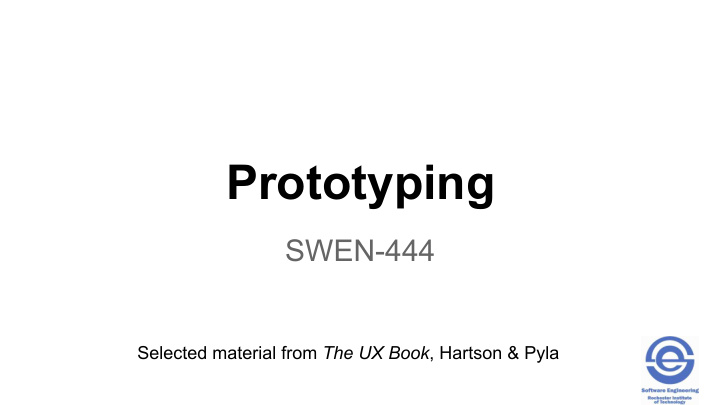



Prototyping SWEN-444 Selected material from The UX Book , Hartson & Pyla
Evaluate design before it’s too late and too expensive.
Prototypes must be less than the full system. • Horizontal – overview of feature coverage, but more abstract so less effective evaluation • Vertical – more depth for a few features with more effective evaluation • “T” – the “middle way”, mostly horizontal with a few vertical features • Local – where horizontal and vertical slices intersect; analyze isolated concern, e.g., icon design
Dimensions of Fidelity of Prototypes • Breadth - % of features covered • Depth – degree of functionality • Look: appearance, graphical design - Sketchy, hand-drawn • Feel: input method, degree of interaction - Pointing & writing feels very different from mouse & keyboard
Fidelity of Prototypes • Low fidelity • Paper sketches, story boards or simple wireframes • Low fidelity in look and feel, more abstract • Can be effective in user evaluation • Why paper ? • Easy, fast, and low cost to create and change • Creative focus on design not on the drawing or programming tool • Designer in control during user evaluations
Fidelity of Prototypes • High fidelity • Include details of appearance and interaction behavior • Users see more complete design • Advanced wireframes with navigation (medium fidelity) • Programmed without being the final product • Backend simulation • Storyboard animations
What Type of Prototyping? • Progress prototype fidelity during the design life cycle to… • Understand the ecological (low), interactive , and emotional perspectives (high) and to …. • Focus on behavior first then appearance Ideation Low fidelity paper sketches Conceptual design Low fidelity paper sketches, storyboards Intermediate design Low to medium fidelity wireframes Detailed design High fidelity wireframes, programmed prototypes
Cautions • Rationalize cost-value tradeoffs to gain budget support • Do not oversell - capabilities that can’t be delivered, development completeness • Do not overbuild – “good enough” as a prototype • Decide early on exploratory or evolutionary prototypes
Prototyping Tool (Individual Activity) Do some research and select the tool you plan to use to develop your high fidelity prototype. List the tool’s pros and cons, and why you decided on using it. Submit your answer to myCourses.
Recommend
More recommend